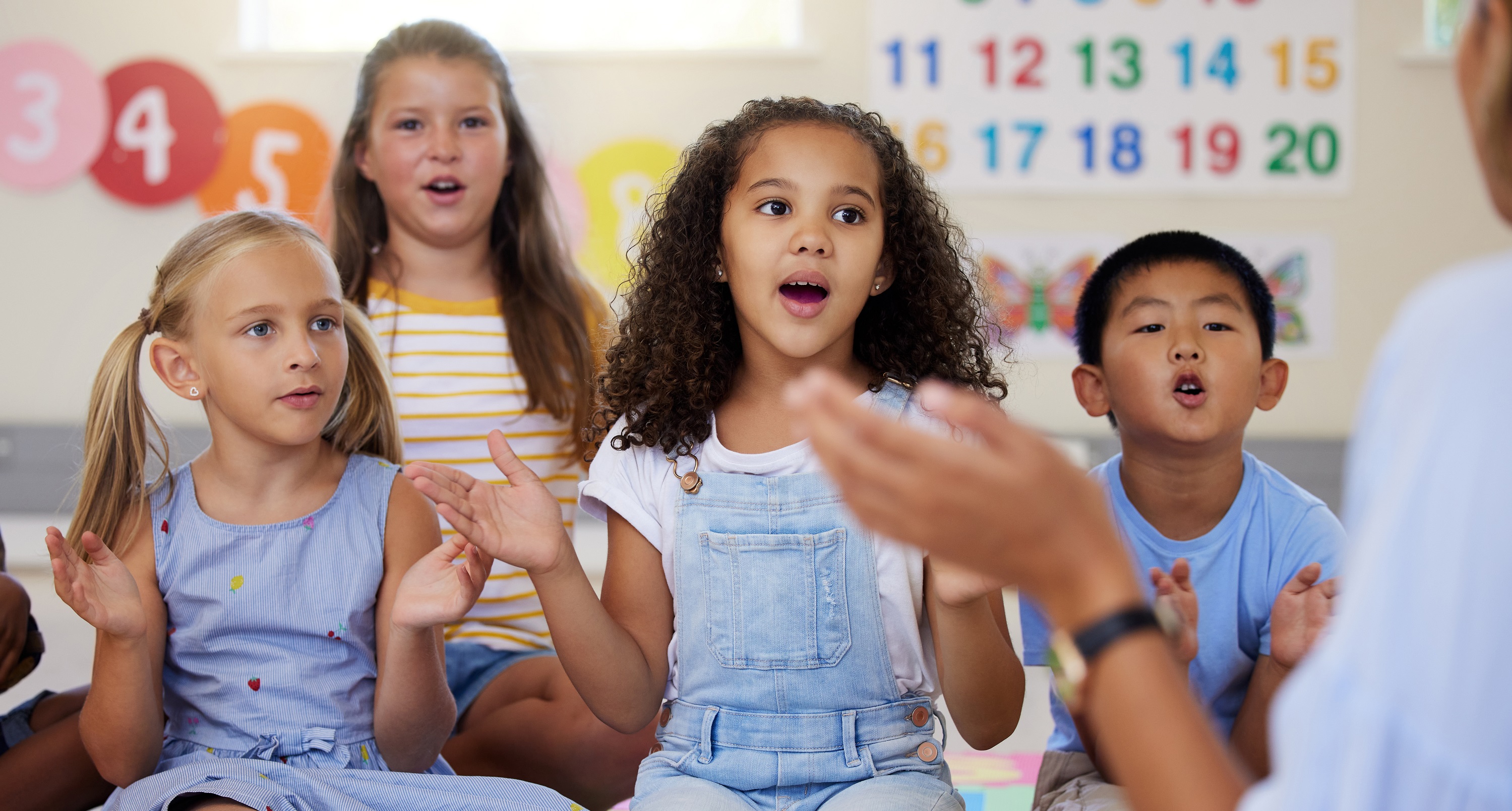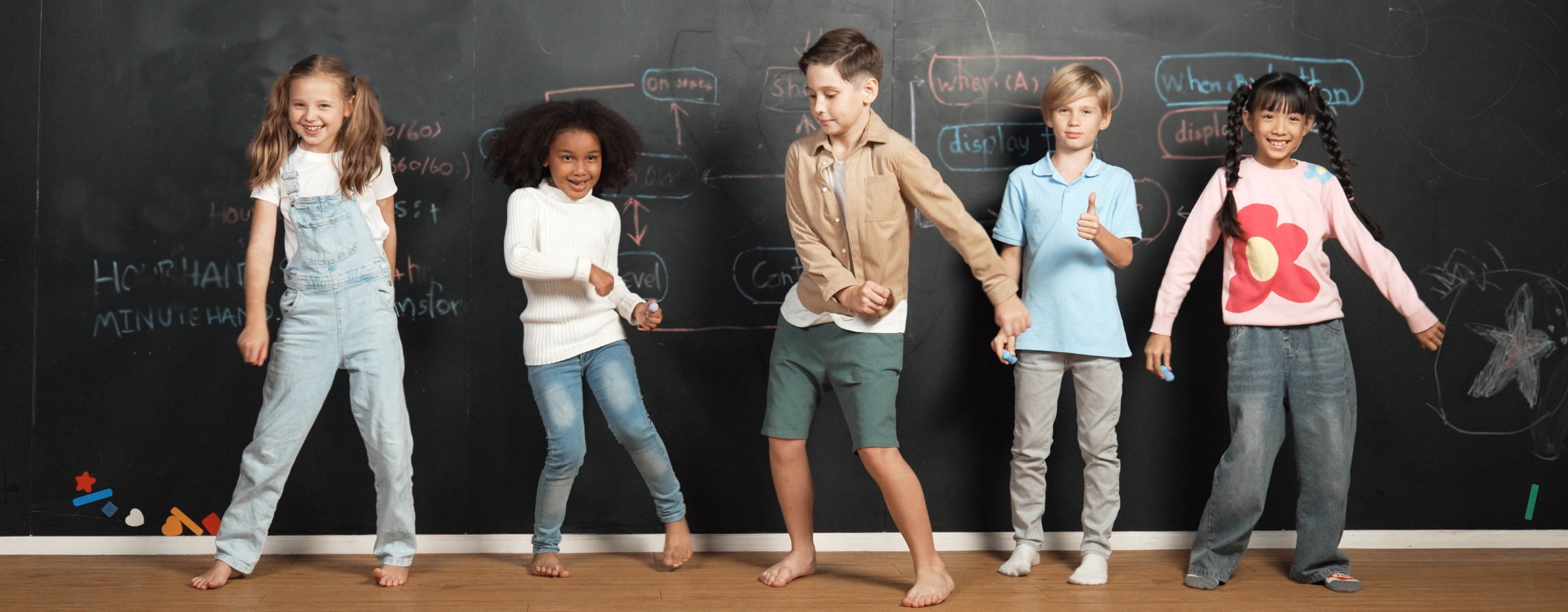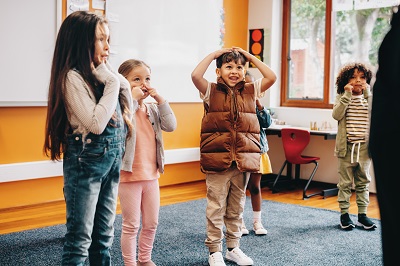3 Ways to Learn Language With Music in Primary Education

Have you ever noticed how young learners pick up new words more easily when they sing along? Music combines lyrics, melody, and rhythm to form a universal language that transcends cultural and language barriers. Different types of music (e.g., folk songs, chants, lullabies, and pop tunes) engage children more or less depending on their tempo, emotional tone, meaning and cultural relevance, making music an incredibly versatile tool in primary English language teaching (ELT) classrooms.
Previous blogs explored how music can set the tone in the classroom for lively and quiet classrooms, along with signaling transitions during literacy rotations. If you haven’t read these blogs yet, have a look at the section titled “2. Create Distinct Atmospheres” from The Literacy Rotation Master Plan for ideas on creating immersive experiences for younger learners.
Beyond mood-setting, music also supports multimodal language learning, engaging multiple senses and learning styles to help younger learners better understand and remember new language forms. For instance, music supports:
-
- Auditory skills through listening to melodies, rhythms, and lyrics
- Kinesthetic skills by clapping or dancing along with the beat
- Visual skills when watching videos or reading lyrics
- Linguistic skills through exposure to vocabulary, sentence structures, and pronunciation
Considering these benefits, learning language through music doesn’t need to be complicated. One of the greatest advantages of using songs in the ELT classroom is the multiple layers involved. At its simplest, each song consists of words, music, and a beat, which can be flexibly used in various ways for specific language lessons. More specifically, each layer can stand alone as a meaningful activity or be combined for a multimodal learning experience. Following, I share three ways to include music as a multimodal learning tool for primary ELT classrooms to inspire ideas for enhancing younger learners’ language development.
1. Using Lyrics to Support Reading Development
Song lyrics make engaging reading texts that help learners focus on vocabulary, sentence structure, and phonics. The key is to select age-appropriate lyrics with clear narration suitable for learners’ language proficiency and interests to ensure that content is engaging and relevant. This also makes it easier to format song lyrics as separate handouts or shared visual slide decks for independent or group reading.
Nursery rhymes and educational songs work well with their simple stories, vocabulary, and rhyming patterns, suitable for both reading and singing. Some examples for beginner to lower intermediate levels include:
-
- Bingo: A narrative introducing a dog named Bingo with both letter and word recognition.
- Five Little Ducks: A counting rhyme about ducks that supports number recognition from five to one.
- Itsy Bitsy Spider: A short narrative recounting the actions of a spider climbing with action verbs and prepositions.
- This Old Man: A clear narrative about a character playing a game that supports numbers increasing each verse up to ten.

Reading through the lyrics before singing is also a great way to introduce a new song to the class, as it builds familiarity with the language. Additional supplementary material like glossary lists, or preteaching key words, can be provided to support unfamiliar or difficult words. Follow-up discussion questions can also be included to develop reading comprehension.
2. Listening to Songs for Active Language Engagement
Focused listening activities with audio or video clips can create active engagement with the target language, developing both visual and auditory skills. Depending on the language focus, listening to the song helps younger learners tune into pronunciation, rhythm, intonation, and comprehension. Here are some example activities:
-
- Fill-in-the-Lyrics: Prepare a handout of the chosen song lyrics with missing words focusing on a specific grammar point, vocabulary set, or a mix of forms, depending on the learners’ proficiency and language goals. For example, “Because I’m ____. Clap along if you feel ____ is the truth.” (from “Happy” by Pharrell Williams)
- Find Rhyming Pairs: Have students listen to the selected song and identify rhyming pairs. Example of a rhyming pair from a nursery rhyme would be “Dock” and “Clock” (from “Hickory Dickory Dock”) or “Go” and “Know” (from “Let It Go” in Disney film, Frozen). Students could either write the rhyming pairs down or raise their hand when they have identified a pair.
- Draw the Scene: Use songs with imaginative or fun lyrics suitable for kids and ask students to draw what they hear. One song that comes to mind is “Down by the Bay,” which has funny sentences like “Have you ever seen a duck, driving a truck, down by the bay?” Students can share and describe their drawings with their classmates.
 To support various levels, songs with slower or faster tempos can be used with or without lyric handouts. Scaffolding can also include preteaching key words or replaying specific lines.
To support various levels, songs with slower or faster tempos can be used with or without lyric handouts. Scaffolding can also include preteaching key words or replaying specific lines.
3. Performing Songs to Build Language Fluency
Performing songs helps learners practice pronunciation, rhythm, and sentence stress in a natural, memorable way. Depending on the classroom dynamics, this can begin as simple singalongs and gradually develop into full class performances or interactive singalongs with movements.
A range of age-appropriate educational and popular songs (in English or with English versions) can be introduced into the classroom. Involving students into the song selection process can boost motivation and interest, but remind students that all song suggestions will be reviewed first.
Another engaging approach is to combine singing with movement as part of an interactive class challenge. Some songs include choreographed or suggested actions, which can reinforce vocabulary through word-action association, supporting both language acquisition and kinesthetic skills.
Some classic educational songs with actions include:
-
- “Head, Shoulders, Knees, and Toes,” by pointing to body parts as you sing.
- “If You’re Happy and You know It,” by doing the actions instructed (e.g., clap, stomp)
- “The Hokey Pokey,” by moving body parts in/out of the circle and turning around.
While these songs were designed for early primary grades, learners in higher primary grades might still find the songs amusing, especially when linked to specific vocabulary or themes.
Staying up to date with popular songs can also keep lessons fresh and relevant. Songs which were once trendy, like “Baby Shark,” can be fun to introduce (or reintroduce) in class, particularly when they include specific choregraphed moments. For example, “Baby Shark” has gestures representing cartoon-like features of different family members (e.g, baby, mummy, daddy, grandma, grandpa) and verbs like “hunt” and “run away.” Performing the song as a class, even just once or twice, can offer a fun, memorable way to reinforce vocabulary related to family and actions, even for older primary learners.
In the groove of things, there are so many songs to choose from based on genre, topic, and interest to enrich your language lessons for younger learners. These are only three of the many ways to use different layers of music to help inspire more rhyme and rhythm in your classroom.
So, if you love music and you know it, include more in your lessons!
 Happy Teaching and Learning!
Happy Teaching and Learning!

